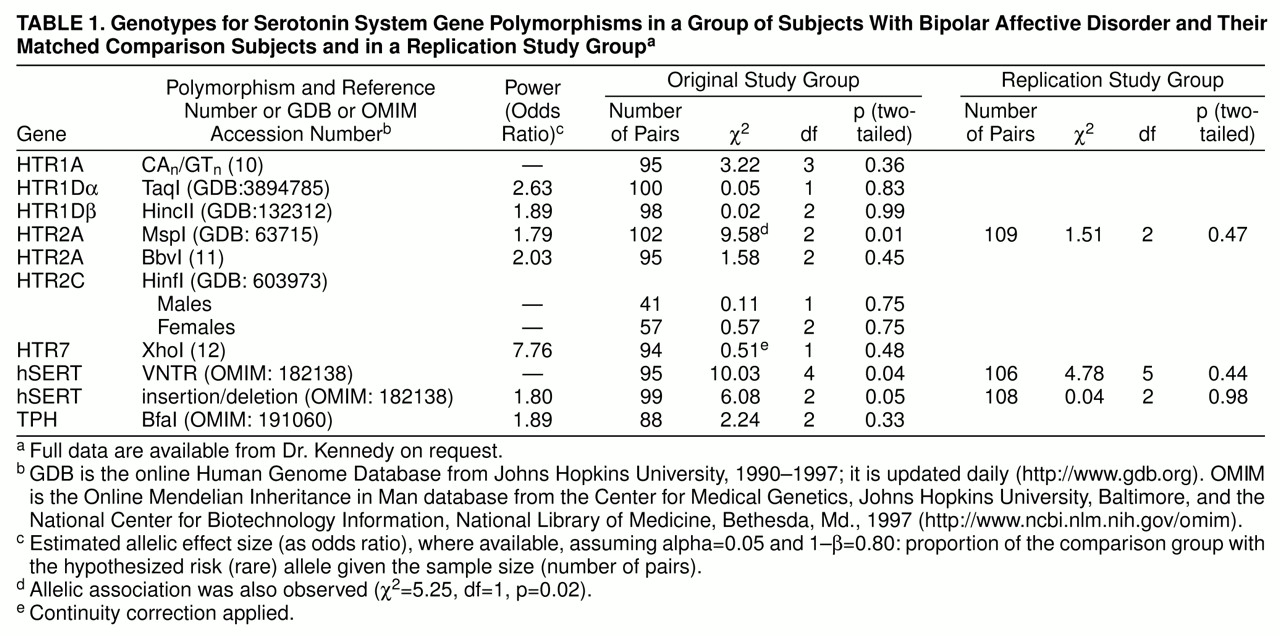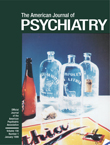The role of the serotonin system in affective disorders has been the subject of extensive research
(1). In particular, many antidepressant drugs used for treating the depressive phase of bipolar affective disorder target the serotonin system
(2). Evidence from twin, adoption, and family studies suggests that a strong genetic factor is implicated in bipolar affective disorder
(3). A number of studies of candidate genes have also implicated serotonin genes in bipolar affective disorder, most notably HTR2A
(4), HTR2C
(5), the serotonin transporter (hSERT)
(6), and tryptophan hydroxylase (TPH)
(7). In an attempt to replicate these prior studies and to provide a comprehensive assessment of the genetic involvement of the serotonin system in bipolar affective disorder, we conducted association studies of 10 polymorphisms in eight candidate genes from the serotonin system (HTR1A, HTR1Dα, HTR1Dβ, HTR2A, HTR2C, HTR7, hSERT, and TPH).
METHOD
Individuals with bipolar affective disorder were recruited from the Bipolar Clinic at The Clarke Institute of Psychiatry, Toronto. They met the Research Diagnostic Criteria for bipolar affective disorder as determined by interview with the Schedule for Affective Disorders and Schizophrenia—Lifetime Version
(8). All of the bipolar subjects (N=103) were classified as having bipolar affective disorder, type I. The comparison subjects were recruited from staff members at Case Western Reserve University, Cleveland, and the local community around The Clarke Institute and had no history of major psychiatric illness. They were closely matched pairwise to the unrelated bipolar subjects in age (± 5 years), sex, and detailed ethnic background, including preimmigration roots. The mean ages of the affected subjects and the comparison group were similar (mean=39.16 years, SD=10.83, and mean=38.07 years, SD=10.41, respectively; t=0.73, df=204, p=0.46, two-tailed test). In both groups 57% (N=59) of the subjects were female and 43% (N=44) were male; 95% were Caucasian, 3% Oriental, and 2% Native Canadian. All individuals in the comparison group were above the median age at onset for bipolar affective disorder (18 years for males, 20 years for females)
(9) and thus had largely passed through the age of risk for developing the disorder.
In order to corroborate or refute any positive findings in the group with bipolar affective disorder, candidate genes demonstrating positive associations were examined in an independent replication sample of 109 individuals with bipolar affective disorder, type I (diagnosed with use of the same criteria that were used for the original study group) and a paired comparison group matched in sex and ethnicity (all patients and comparison subjects were Irish, Scottish, Welsh, or English with United Kingdom or Irish ancestry). Local ethical committee approval and written consent from each subject were obtained.
Blood was drawn and DNA was extracted. The genotype data were analyzed with chi-square tests (SPSS 7.0, Chicago). Linkage disequilibrium was assessed by a maximum likelihood method.
RESULTS
The polymorphisms genotyped in the patient and comparison groups and the results of the analysis are shown in
table 1. Polymerase chain reaction genotyping was performed as specified in the references in the table. Patient and comparison group genotypes were in Hardy-Weinberg equilibrium for all of the polymorphisms. The frequency of the C102 allele for the HTR2A MspI polymorphism was significantly elevated among the affected individuals. Also, a significant decrease in the frequency of heterozygotes was observed for the hSERT insertion/deletion polymorphism in the affected group. For the hSERT variable number of tandem repeats (VNTR) polymorphism, an increase in frequency of the 12/12 homozygotes was observed in the affected group.
These results become nonsignificant once multiple testing has been taken into consideration. Furthermore, within the replication sample, both hSERT polymorphisms and the HTR2A MspI polymorphism were not significantly different in the affected group and the comparison group. Strong linkage disequilibrium was observed between the hSERT VNTR and insertion/deletion polymorphisms (χ2=25.21, df=2, p<0.001). Linkage disequilibrium between the HTR2A MspI and BbvI polymorphisms was weak and not statistically significant. Under both dominant and recessive models, no haplotype associations with bipolar affective disorder were observed for the HTR2A and hSERT polymorphisms.
DISCUSSION
Overall, these results do not support a role for serotonin system genes in bipolar affective disorder, and they contradict several recent publications that have suggested positive associations with affective disorders
(4–
7). No conclusions can be drawn concerning HTR1A and HTR7, because the polymorphisms used were too infrequent, and thus the sample power was too low. However, since extensive screening for mutations within the coding region and promoters of these genes has been performed, and only very rare mutations have been found
(13,
14), it seems unlikely that mutations at these genes play a major role in bipolar affective disorder. A number of other important genes in the serotonin system, such as HTR4 and HTR5, have not yet been studied for genetic involvement in bipolar affective disorder owing to the lack of availability of suitable polymorphisms.
Our study differs from previous studies in that the comparison group was carefully matched pairwise in age, sex, and ethnicity, in order to diminish effects of population stratification. We also used an independent replication sample, which failed to corroborate the findings in the initial sample. With the use of a family-based comparison group versus ill individuals, as in a transmission disequilibrium test, the problem of population stratification is eliminated. In order to more fully investigate the genetic involvement of serotonin genes in bipolar affective disorder, we propose a transmission disequilibrium test study in a minimum of 200 individuals with bipolar affective disorder and both parents to analyze whether specific alleles at these genes are transmitted more frequently from parents to affected individuals (subjects for such a study are currently being collected).


